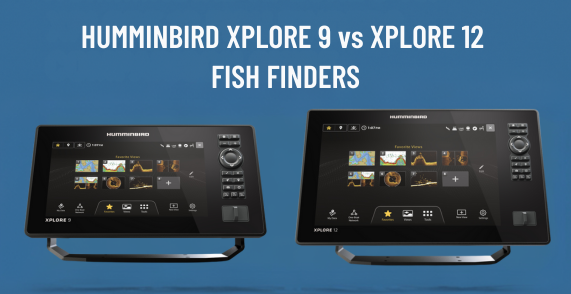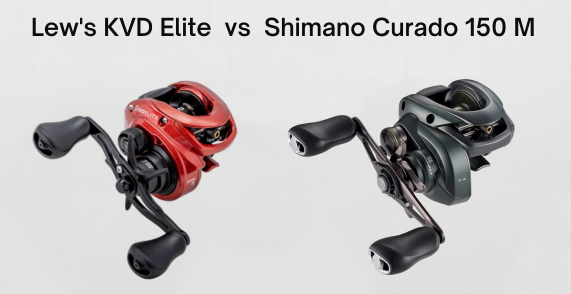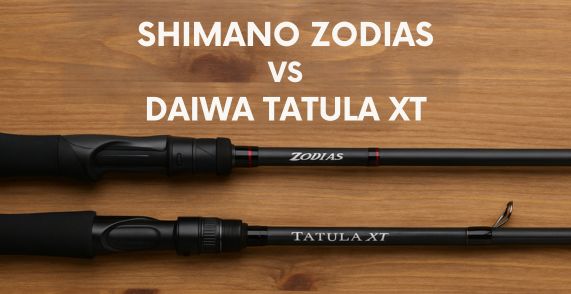In This Post
- 1 Key Takeaways
- 2 Same Sonar Power, Different Screens: The Key Trade-Off
- 3 Display Dimensions That Actually Matter
- 4 Identical Sonar Performance Across Both Models
- 5 Power Consumption and Battery Impact
- 6 Networking and Integration Features
- 7 Pricing: $1,499 vs $2,699 with Transducer Included
- 8 The 12-Inch Model Wins for Multi-Screen Users, 9-Inch Delivers Better Value
Key Takeaways
- Both the Xplore 9 and Xplore 12 offer identical sonar performance with MEGA Imaging+ and Dual Spectrum CHIRP technology, ensuring the same fish-finding capabilities regardless of screen size
- The primary difference lies in display dimensions: 9-inch versus 12.1-inch screens, with the larger model providing 60% more viewing area for multi-panel displays
- Pricing reflects a $1,200 difference ($1,499 vs $2,699 with transducer) for the CMSI+ models, making screen size the main value consideration
- The 12-inch model excels for split-screen navigation and sonar combinations, while the 9-inch delivers superior value for single-panel usage
- Power consumption differences are minimal (2.2A vs 2.4A), with both models supporting identical networking and integration features
When choosing between the Humminbird Xplore 9 and Xplore 12, anglers face a straightforward decision: identical fish-finding performance with different screen real estate and pricing.
Both models represent Humminbird’s latest advancement in fish finder technology, featuring lightning-fast quad-core processors and enhanced user interfaces designed for serious fishing applications.
Same Sonar Power, Different Screens: The Key Trade-Off
The fundamental reality of the Xplore series comparison centers on screen size versus budget considerations. Both units deliver identical sonar capabilities, processing power, and networking features—the only meaningful differences lie in display dimensions and the resulting price gap.
This creates a clear value proposition: pay more for screen space or save money without sacrificing fish-finding performance.
The 9-inch model measures 297mm wide by 159mm high, while the 12.1-inch version expands to 359mm wide by 215mm high.
This translates to approximately 60% more viewing area on the larger model, which becomes particularly valuable for complex multi-panel configurations combining sonar, charts, and navigation data.
Testing and analysis of both models confirms that screen size represents the primary decision factor, with all other specifications remaining functionally identical.
Understanding how this screen difference impacts real-world usage helps determine which model suits specific fishing styles and boat configurations.
Display Dimensions That Actually Matter
Screen Size and Real Estate Comparison
The physical dimensions create distinct usage scenarios for each model. The Xplore 9’s compact footprint suits smaller console spaces and boats where mounting area is limited, while maintaining excellent visibility for single-panel sonar views.
The display provides sufficient detail for most fishing applications, particularly when using traditional sonar or single imaging modes.
The Xplore 12’s larger canvas becomes advantageous when displaying multiple information sources simultaneously.
Split-screen configurations showing side imaging alongside down imaging, or combining sonar with detailed chart work, benefit significantly from the additional real estate. Multiple anglers can view the screen comfortably from various positions around the helm.
Resolution and Clarity Analysis
Resolution specifications reveal subtle differences that impact image quality. The Xplore 9 features 1280 x 720 HD resolution, while the Xplore 12 offers 1280 x 800 WXGA resolution.
The additional 80 vertical pixels on the larger model provide slightly more information display capability, though pixel density remains comparable between units.
Both displays incorporate anti-glare, edge-to-edge screens engineered specifically for polarized eyewear compatibility.
This ensures optimal visibility in bright sunlight conditions common during fishing expeditions. The screen technology delivers vibrant colors and sharp contrast across both models, maintaining excellent readability at various viewing angles.
Multi-Panel Display Advantages
Multi-panel configurations highlight the 12-inch model’s strengths most clearly. When displaying three or four information panels simultaneously—such as traditional sonar, side imaging, down imaging, and chart data—the larger screen prevents cramped layouts that compromise readability.
Each panel maintains sufficient size for effective interpretation of fish signatures and structure details.
The 9-inch model handles dual-panel displays effectively but reaches practical limits with three or more simultaneous views.
Single-panel usage remains excellent on both models, with the size difference becoming less significant when focusing on one primary sonar or imaging mode.
Identical Sonar Performance Across Both Models
MEGA Imaging+ Enhanced Detail
Both models deliver identical MEGA Side Imaging+ performance.
The Xplore 9 provides crystal-clear side imaging up to 800 feet range with 455kHz frequencies and 250 feet with MEGA frequencies (1100-1200kHz), while the Xplore 12 offers up to 800 feet with 455kHz and 400 feet with MEGA frequencies.
This technology offers 20% more detail and 60% more range capability compared to previous MEGA Side Imaging systems, revealing structure and fish positioning with exceptional clarity.
MEGA Down Imaging+ capabilities remain consistent across both units, offering underwater clarity down to 400 feet with 455kHz and 200 feet with MEGA frequencies (1125-1225kHz).
The enhanced detail reveals individual fish near bottom structure and distinguishes between closely spaced targets that traditional sonar might display as single returns.
Dual Spectrum CHIRP Capabilities
CHIRP sonar specifications match perfectly between models, supporting Full Mode (150-220 kHz @ 25/42°), Narrow Mode (180-240 kHz @ 25°), and Wide Mode (140-200 kHz @ 42°). This flexibility allows optimal frequency selection based on depth, structure type, and target species preferences.
Both units support advanced sonar compatibility including MEGA Live 2 forward-facing sonar, MEGA 360 imaging, and standard frequencies (50/83/200/455/800kHz). This sonar ecosystem ensures compatibility with specialized applications and future technology upgrades.
Power Consumption and Battery Impact
Power efficiency shows minimal variation between models, with the Xplore 9 drawing 2.2A nominal current at 12V compared to the Xplore 12’s 2.4A draw.
Using a typical 100Ah lithium battery, the 9-inch model provides an estimated maximum of approximately 48.5 hours of operation versus 44.4 hours for the 12-inch version—a negligible difference in practical terms, though real-world usage varies based on settings and conditions.
Both units operate on identical 10-20V input ranges with 8000W peak-to-peak and 1000W RMS power output specifications.
This consistency ensures similar installation requirements and battery system planning regardless of screen size selection. The slight power difference reflects the larger display’s LED backlight requirements rather than processing or sonar power variations.
Networking and Integration Features
One-Boat Network Compatibility
Both models integrate seamlessly with Minn Kota trolling motors, Cannon downriggers, and other One-Boat Network devices.
Three programmable network buttons provide quick access to essential functions like Spot-Lock positioning, shallow water anchor deployment, and GPS navigation commands. This integration eliminates the need for separate control units and creates a unified boat control system.
Network compatibility extends to Humminbird’s complete ecosystem, allowing data sharing between multiple fish finders, radar units, and autopilot systems.
Both models support identical networking protocols, ensuring no functional limitations based on screen size selection.
Navigation capabilities remain identical across both models, featuring internal dual-band GPS for enhanced position accuracy and Humminbird Basemap coverage including over 10,000 lakes and coastal coverage.
CoastMaster and LakeMaster chart compatibility provides detailed bathymetric data for specific fishing locations.
The units support Navionics Gold, Platinum+, and HotMaps Premium charts, offering flexibility in chart selection based on fishing areas and detail requirements.
Waypoint management allows syncing up to 10,000 waypoints to smartphones with custom colors and icons for easy identification and organization.
Connectivity Options
Connectivity specifications match completely between models, featuring Wi-Fi for software updates and app connectivity, Bluetooth for device pairing, Ethernet for high-speed networking, and NMEA 2000 for marine equipment integration.
Dual Micro SD card slots provide storage expansion for charts, waypoints, and sonar recordings.
The Cross Touch interface combines touchscreen operation with physical keypad controls, ensuring reliable operation in various weather conditions. Both models feature the same lightning-fast quad-core processor delivering smooth operation and responsive touch interactions.
Pricing: $1,499 vs $2,699 with Transducer Included
Pricing structures clearly reflect the screen size premium, with the Xplore 9 CMSI+ retailing for $1,499.99 including a Compact MEGA Side Imaging Plus transducer, while the Xplore 12 CMSI+ commands $2,699.99 for the identical package with the larger display.
This $1,200 price difference represents approximately 80% premium for the additional screen real estate. Control Head Only options are also available for both models at different price points.
Value analysis reveals that the price difference exclusively reflects display costs, as sonar performance, processing power, and feature sets remain identical.
This creates a straightforward cost-benefit calculation based on screen size requirements and budget constraints.
The 9-inch model delivers exceptional value for anglers prioritizing fish-finding performance over display size, while the 12-inch version justifies its premium for users requiring maximum screen space for complex multi-panel configurations.
The 12-Inch Model Wins for Multi-Screen Users, 9-Inch Delivers Better Value
The decision matrix becomes clear when considering specific usage patterns and priorities.
The Xplore 12 excels for anglers who frequently utilize split-screen displays combining sonar, imaging, and chart data simultaneously. The additional screen real estate prevents cramped layouts and maintains readability across multiple information panels.
Tournament anglers and those fishing large bodies of water where detailed chart work combines with intensive sonar usage will appreciate the expanded display capabilities.
Conversely, the Xplore 9 represents superior value for anglers focused primarily on sonar performance and fish-finding capabilities.
Single-panel usage remains excellent, and the $1,200 savings can fund additional fishing equipment, premium transducers, or extended fishing trips.
Smaller boats with limited console space also benefit from the compact footprint while maintaining full access to Humminbird’s advanced sonar technologies.
Both models deliver identical fish-finding performance through MEGA Imaging+ technology, Dual Spectrum CHIRP capabilities, and networking features—ensuring no compromise in core functionality regardless of screen size selection.
The choice ultimately depends on display preferences, available space, and budget allocation rather than sonar capabilities or feature limitations.






